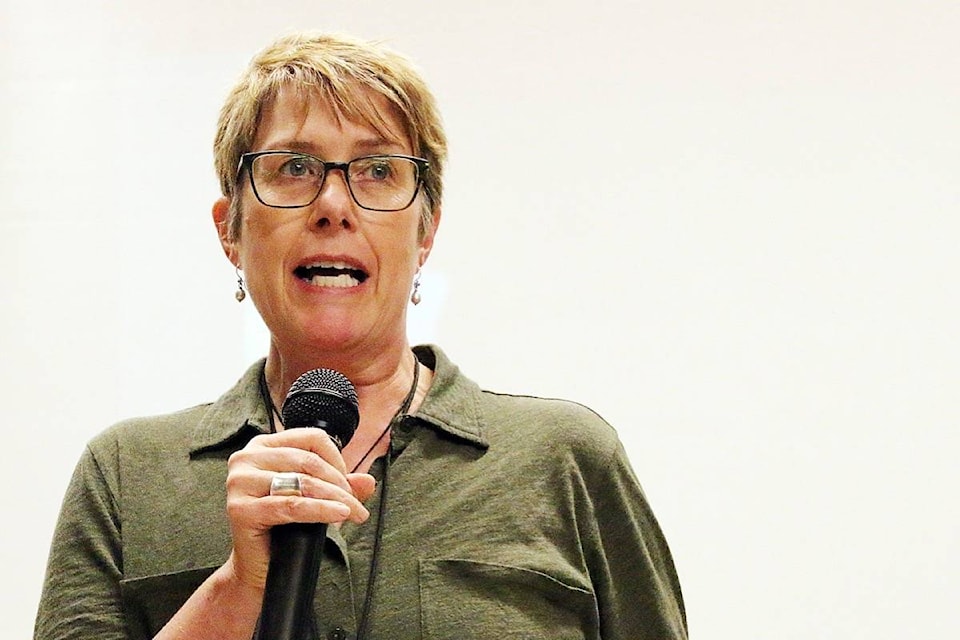“We’ll see massive changes in your area,” the CVRD’s Kate Miller told Lake Cowichan town council on Tuesday, Aug. 8. “We can’t just go back and wish it away.”
Miller, environmental services manager for the regional district, had come to council’s economic and sustainable development committee to to talk about the future under a new climate change regime.
A report has been released recently on that subject and face-to-face conversations with councillors were really needed to bring home the magnitude of the emerging situation, she said.
Municipal governments in the Cowichan Valley will have to continue to operate in a new world, one that could see as many as 80 days in a year with temperatures over 25 degrees by 2050.
“We are just one of the stakeholders. We want to make sure we are not just acting on our own.”
In addition, the Cowichan Valley Regional District covers a lot of ground.
“It goes from the eastern part, which is one of the driest places in Canada to the west coast, which is one of the wettest places.”
The second phase really looks at risk: “What’s the hazard level? Say, for example, drought. We used to think one in 20 years was acceptable. Out of the last 13 years, eight years have been classified as essential drought. This thing is ramping up very quickly.”
The effects on municipalities will vary, but there will be new challenges.
“Road salting might not be such a big deal anymore but black ice might be, and a different [method] of snow plowing,” she said.
“We want to ask the question: if we have more intense rainfall, what is the probability of slope failure affecting a community? We’ll be looking at updating our flood plain mapping, storm water management, and sea water rise.”
Once risk assessment is completed, then it’s time for a very structured process, she said.
“Then we can say: how do we adapt to that vulunerabilty, how do we live with it?”
That could mean suggesting that the building community add more nails to the roof if wind becomes a problem.
Future councils will be considering the likelihood of major algae blooms in the lake and upgrading water systems to take that into consideration, according to Miller.
It will require innovation and forethought.
“I won’t pretend to any of you that at the end of the day there is a magic bullet.
“What you see outside right now is a lot of smoke and the likelihood is that no future actually doesn’t have smoke in our environment. For this particular region, you’re looking at some very substantial changes to temperature.”
Rocketing summer temperatures elsewhere can make people relocate to Cowichan, with more calls on electricity for air conditioning here, she said.
Projections also predict that summer nights will lose their evening cooling.
“It is likely going to get a lot hotter. For many communities this is going to boil down to a massive economic issue which will affect all of your businesses. [As a municipality], you will face pressure to maintain your existing level of service while upgrading your infrastructure.”
The cost of groceries, transportation, and insurance could all be affected, she said.
Municipalities have to look at how these ideas affect their policies and more.
“We will be launching in September a purple air monitoring system. People will be able to log on, see what the air quality is at any particular time.”
Coun. Tim McGonigle said he was worried about invasive plant and animal species and what will happen to what’s here now.
Miller replied that the scientists are already on that. At the Lake, it means large landscapes that are going to be under substantial stress from winter drought and pests.
“We also look at invader species, like fire ants, that are now in the south end of our region, moving fairly quickly. That’s an example of a species we really want to keep control of.”
Foresters are working very hard at planting species now that will live successfully in a completely different climate, like pine.
McGonigle agreed.
“Over the last decade I’ve seen the impact of climate change on western red cedar.”
He was concerned about the impact of that on native ceremonial culture, “which would be a tragedy in my opinion.”
Miller said a similar comment could be made about fisheries.
“The salmon is an iconic species which is really important to our sense of place, whether you’re First Nations or not.”
Fish might survive hotter temperatures with plenty of flow in the river but if the Valley sees another year like 2016, it would mean “we would have ‘kill temperatures’ in the river at this point in time in future,” she said.
Mayor Ross Forrest said, “This will play a major role in decision-making for the weir: raising it or not raising it, or a new weir. The impacts of that will be huge.”
Forrest, like many of us, has been watching the thermometer, noticing that Lake Cowichan has about 16 days a year with temperatures at more than 25 degrees.
“When you see what’s going to happen in the next 50 years, where it’s going to go up to 78 days a year over those temperatures, it is going to affect what kind of community we are and what type of community we are going to become,” the mayor said.
Miller said that the changes could also mean that wintertime freezing becomes a thing of the past at Lake Cowichan.
